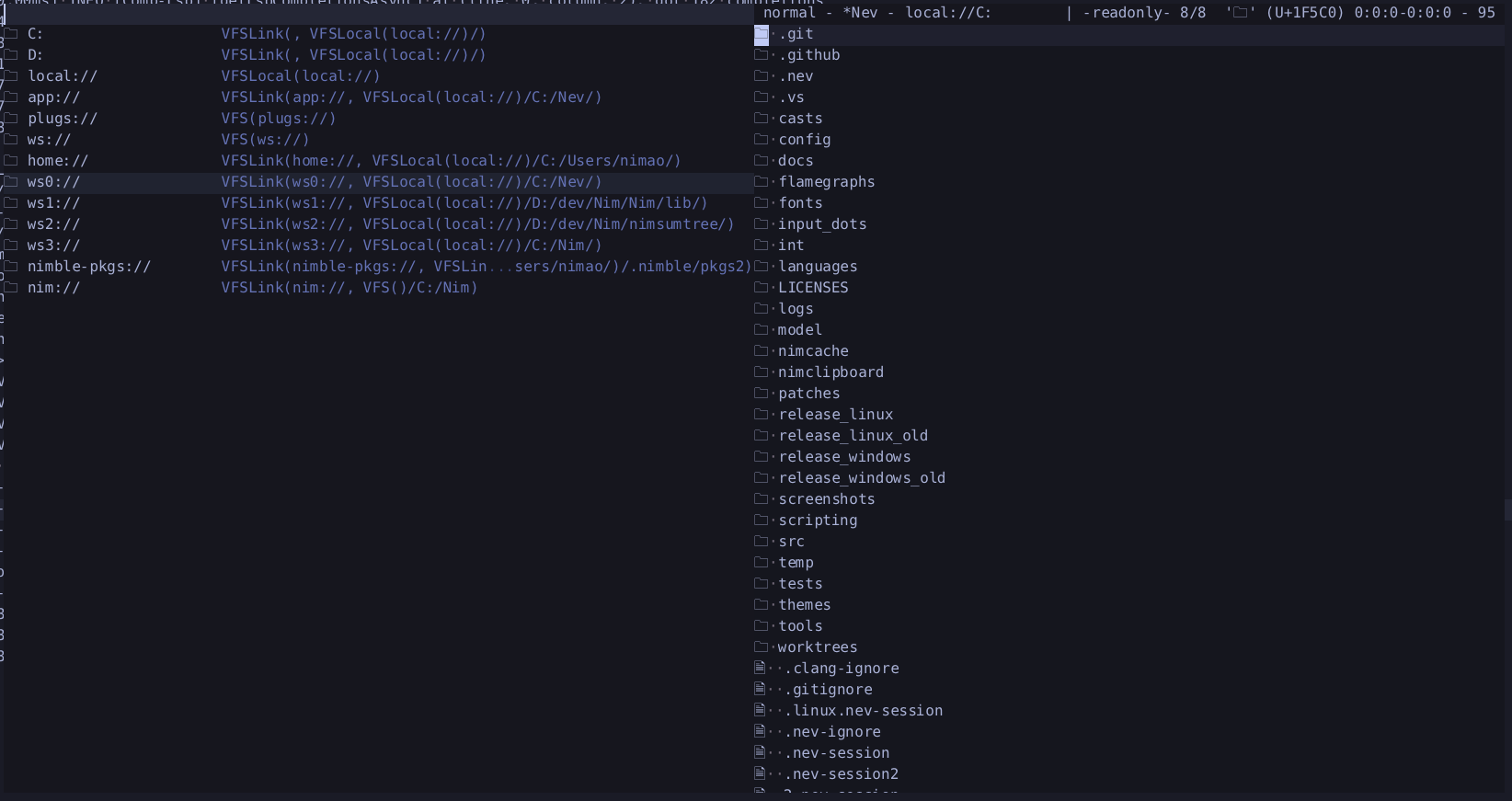Nev uses a virtual file system internally. The VFS is a tree of different types of file systems (local, in-memory, remote, etc.).
Here are the types of file systems that are supported:
VFS- The base type for all other file systems, which can be used as a container/folder for other VFSs.VFSInMemory- This file system stores files in RAM.VFSLocal- This represents your local filesystem.VFSLink- This file system can link into a subfolder of another file systems. Cycles are not allowed.
By default Nev creates a VFS hierarchy which contains the local file system under local://, and some links into that for convenience:
app://links to the directory where Nev is installed underlocal://home://links to the user home directory underlocal://ws0://,ws1://etc. link to the workspace folders.ws://0,ws://1etc. link to the workspace folders.plugs://, contains plugin sources (if available)
To explore the entire VFS in the builtin file explorer you can run the command explore-file "" true (to see some more info about the VFSs) or just explore-files
You can also see the VFS hierarchy by running the command dump-vfs-hierarchy, which will output something like this to the log file:
VFS()
'' -> VFSLink(, VFSLocal(local://)/)
'local://' -> VFSLocal(local://)
'app://' -> VFSLink(app://, VFSLocal(local://)//home/xyz/Nev)
'plugs://' -> VFS(plugs://)
'keybindings_plugin' -> VFSInMemory(keybindings_plugin)
'my_plugin' -> VFSInMemory(my_plugin)
'ws://' -> VFS(ws://)
'0' -> VFSLink(0, VFSLocal(local://)//home/xyz/my project)
'home://' -> VFSLink(home://, VFSLocal(local://)//home/xyz)
'ws0://' -> VFSLink(ws0://, VFSLocal(local://)//home/xyz/my project)
Here is a visual representation of what the above VFS hierarchy:

With the given VFS, the following paths would refer to these files:
| VFS Path | Normalized path | Explanation |
|---|---|---|
local:///home/xyz/Nev/nev.exe |
local:///home/xyz/Nev/nev.exe |
The local:// prefix refers to a VFSLocal, which itself doesn't link to other VFSs. |
/home/xyz/Nev/nev.exe |
local:///home/xyz/Nev/nev.exe |
This path doesn't match any of the prefixes of the form xyz://, but it does match the VFSLink with an empty prefix, which in turn links to the VFSLocal |
home://Nev/nev.exe |
local:///home/xyz/Nev/nev.exe |
The home:// prefix refers to local:///home/xyz, add to that Nev/nev.exe |
app://nev.exe |
local:///home/xyz/Nev/nev.exe |
The app:// prefix refers to local:///home/xyz/Nev, add to that nev.exe |
ws0://foo.txt |
local:///home/xyz/my project/foo.txt |
The ws0:// prefix refers to local:///home/xyz/my project, add to that foo.txt |
ws://0/foo.txt |
local:///home/xyz/my project/foo.txt |
The ws:// prefix refers to a sub VFS, and in there the 0 prefix refers to local:///home/xyz/my project, add to that foo.txt |
plugs://keybindings_plugin/src.nim |
plugs://keybindings_plugin/src.nim |
The plugs:// prefix refers to a sub VFS, and in there the keybindings_plugin prefix refers to an in memory VFS |
The mount-vfs command can be used to mount new VFSs in the VFS hierarchy:
mount-vfs <parent vfs path> <prefix within parent> <vfs config>
Mount the nimble packages directory under nimble:// to have quick access to nim library source code:
// ~/.nev/settings.json
{
"+wasm-plugin-post-load-commands": [ // Run these commands after loading wasm plugins
[
"mount-vfs",
null, // Null means mount under the root. If a path is provided then it will be mounted under the VFS the given path resolves to.
"nimble://", // The prefix under which to mount the new VFS
{ // VFS description
"type": "link", // create a VFSLink
"target": "home://", // path of the target VFS to link to
"targetPrefix": ".nimble/pkgs2" // Subdirectory within the target VFS
}
]
]
}After running this command the path nimble://package_name/package.nim would refer to home://.nimble/pkgs2/package_name/package.nim, which in turn refers to local:///home/xyz/.nimble/pkgs2/package_name/package.nim
The browse-keybinds finder shows you the source code which defined keybindings (if available). It reads this source code from plugs://<plugin_name>/<source_file>.nim, which by default is mounted as an in memory VFS, containing embedded source code from the wasm binary.
If you develop you're own plugin you might want that to link to you're source code on your local file system instead.
To do this you can remount the filesystem for your plugin like this:
// ~/.nev/settings.json
{
"+wasm-plugin-post-load-commands": [ // Run these commands after loading wasm plugins
[
"mount-vfs",
"plugs://", // Mount the new VFS under the VFS with the prefix 'plugs://'
"my_plugin", // The prefix under which to mount the new VFS
{ // VFS description
"type": "link", // create a VFSLink
"target": "local://", // path of the target VFS to link to, you could also use app:// or home:// or whatever.
"targetPrefix": "/path/to/plugin/source" // Subdirectory within the target VFS
}
]
]
}After running this command the path plugs://my_plugin/source.nim would not refer to the in-memory VFS anymore but to local:///path/to/plugin/source/source.nim instead.
